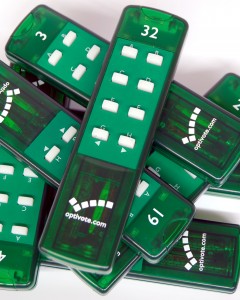 In this post Elaine Hughes, Senior Lecturer in Adult Nursing and a SOLSTICE Fellow, tells us about her experience using an Optivote voting system. If you are inspired to think about using this type of system in your own teaching, there is plenty of support and information available to help you get started.
In this post Elaine Hughes, Senior Lecturer in Adult Nursing and a SOLSTICE Fellow, tells us about her experience using an Optivote voting system. If you are inspired to think about using this type of system in your own teaching, there is plenty of support and information available to help you get started.
Could you set the scene for us?
“As Kurt Lewin said ‘Learning is more effective when it’s an active rather than a passive process’. Therefore maintaining student engagement and enhancing learning in lecturers of around 140 students can prove to be very challenging. Other than written formative tests there are limited ways of assessing whether learning has taken place at the point of contact. Yet, it is well documented that when learning is fun then it can prove to enhance memory and thus stimulate learning.”
What did you do?
“Before the Optivote system was available for use I still used quizzes in the classroom with rewards for the right answers, usually Quality Street, which proved to be very popular with the students. It clearly helped focus their concentration as they were able to give the right answers after a taught session but whether learning had taken place throughout the class couldn’t be evaluated. What you also couldn’t see were how many got the answers right as not all students would attempt to verbally answer. Cue Optivote.”
Why did you do it? What were the drivers?
“The use of a voting system allowed greater student engagement and allowed me to evaluate whether students had understood the key messages in a lecture. It moved the delivery of sessions forward and I think there are probably many other ways to use this in class which could be measured over a period of time.”
How did you use the voting system?
“Because I teach anatomy and physiology initially Optivote lent itself to these sessions. However I have now used the Optivote system in large groups for a number of years across level 4-6 for sessions for different purposes:
- for formative quizzes following anatomy and physiology sessions where the end of module assessment included a summative exam
- as an alternative method of teaching anatomy and physiology, using the questions as a focal point to discuss the reasons for the answers
- in clinical decision making and delegation sessions where students are asked to rationalise their decisions in practice and used as discussion points”
What was the outcome?
“The use of the Optivote handsets really promoted student engagement with the session content and generated discussion among the groups. In terms of ‘did deep learning take place?’ this is much harder to quantify. However in the module where there was a summative exam the pass rates were higher. To make real claims as to whether this was directly related to the use of technology research would have to be undertaken. However what is evident is the students enjoy this engagement as these sessions are consistently highlighted in module evaluations.”
What were the issues and concerns?
“With any technology within the classroom, especially with so many pairs of eyes watching, the fear is always ‘will the system fail’ and ‘have I programmed this correctly?’ There’s a handy guide to setting up your database and loading in your presentation and questions/responses but I think the first time I used it it wasn’t so simple! Although with practice it’s easy to set up and use, but like everything practice makes perfect – however I still always test it before each use!”
What ‘unanticipated outcomes’ were there?
“I wasn’t sure how the students would react. Would they think it was childish to press the button and vote? Would they want to get involved? Would they see it just like ‘who wants to be a millionaire’ and jump in with their answers? I needn’t have worried. What I actually saw at one point was probably the most disengaged group I’d ever taught sit on the edge of their seats, pointing their handsets at the screen and pressing buttons before the voting timer had even started! I did think that this was just a one off response from this particular group but when I demonstrated the use of the equipment to staff I had exactly same reaction! When students go off task in a class they talk. What I also tend to see with Optivote is lots of chatter with their neighbours, but it’s quite obvious they’re discussing the question that’s been posed to them, especially during clinical decision making as this can get quite animated.”
Did the use meet your expectations?
“In terms of student engagement it certainly has met my expectations. Keeping such large groups engaged and interacting, not just with me but with each other and on the subject content, can be difficult. However assessing if learning has taken place is more difficult. The students certainly remember the sessions but do they remember the content!”
What would be your advice to others trying to do this?
“I’m no techno expert by any means but if technology scares you then just speak to someone who has used it. It literally takes 20 minutes to set up your database and then it’s done. After that it’s a couple of minutes to set up in class. Don’t use it too frequently as it becomes too familiar: that way the students continue to engage with the process. Don’t use too many questions and change your format, it keeps the audience on their toes.”
 Elaine Hughes
Elaine Hughes
Senior Lecturer Adult Nursing & SOLSTICE Fellow
